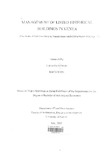| dc.description.abstract | The Kenya Government Policy on sustainable use of both natural and man-made resources is still at its infancy stage. It is therefore no wonder that a number of historic properties are faced with dilapidation.
The management of maintenance intervention of listed historic buildings varies considerably, in terms of determination of standards of maintenance and the applicable individual management style. Maintenance levels are dictated by various factors including as productive efficiency standards, statutory standards and status standards.
By outlining a broad perspective of social, economic, ethical and cultural attributes of historic buildings, this research paper presents a case that every generation has its value system, and that such value system must be premised upon continuous body of historical records. Historic records include built environment, whose management as a measure of institutional memory and generational continuity, is an activity that must be accorded the importance and understanding it deserves.
The study attempted to analyse how historical built environment in Kenya is managed, by highlighting principle actors in the maintenance management of listed historical buildings and the influence of these actors on the determination of standards, and hence the level of care of these cultural properties.
The conservation of historic buildings has always been viewed as a bourgeois concept devoid of contemporary needs of society. This school of thought is more controversial when one considers the concept of putting land to its “Best and Highest” use. It is therefore possible that in a society driven by capitalistic ideals of free enterprise, (Kenya included), certain historic and valuable properties will be the subject of varied maintenance standards, depending on factors that motivate the individual owners of such properties.
Drawing strength from the various conservation ethics, this research paper outlined the
possible strategies that can find relevance in the appropriate management of listed historic buildings. Such strategies can also be equally replicated in conservation intervention on any historical cultural property. | en_US |



